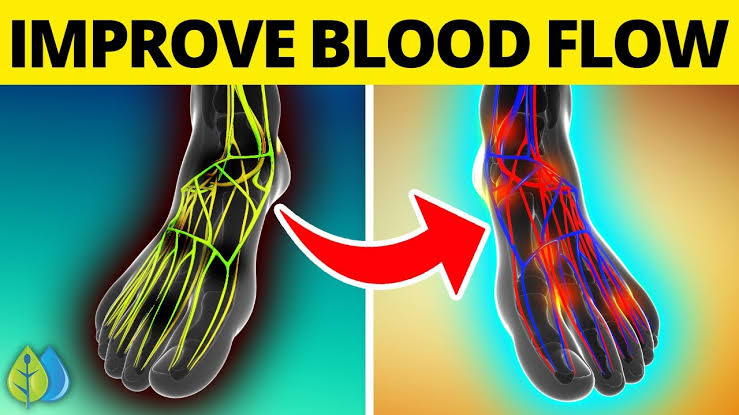
How to stimulate blood circulation
Blood circulation
The blood circulation is the journey in which blood travels from the heart to all parts of the body to provide it with oxygen and nutrients and to rid it of carbon dioxide and waste. Humans have two circulations: the minor circulation, and the major circulation. The minor circulatory system includes the heart and lungs, and this circulation is the one that carries deoxygenated blood from the heart to the lungs to load it with oxygen and excrete carbon dioxide, so that the oxygenated (oxygenated) blood returns to the heart. Then the oxygenated blood is pumped from the heart to all parts of the body, and this process is called the great blood circulation.
Poor blood circulation
Poor blood circulation leads to poor performance of the body’s systems for their vital functions, which leads to many health problems. Poor circulation is defined as decreased blood flow to a particular area of the body, resulting in less oxygen reaching that area (hypoxia). The term poor circulation is used to refer to peripheral arterial disease, a disease that occurs when the arteries that supply blood to the internal organs (such as the stomach and brain), arms and legs become blocked due to atherosclerosis.
One of the most important symptoms associated with peripheral artery disease is spasms in the muscles of the lower extremities, with a feeling of fatigue and pain when moving. There are other symptoms such as difficulty and delay in healing wounds in the feet, poor nail growth due to a decrease in blood flow to those areas, with a clear decrease in the temperature of the feet compared to the temperature in the rest of the body. Smokers and those with diabetes, high blood pressure and cholesterol levels are the most likely to develop peripheral artery disease.
Healthy practices to stimulate blood circulation
The most important way to maintain the effectiveness and efficiency of blood circulation is to maintain the integrity of the heart and blood vessels. Exercising, eating a healthy balanced diet, and avoiding smoking are among the most important pillars for maintaining the integrity of the heart and blood vessels, and thus the health and safety of the circulatory system.
Sports
It is one of the most important means to improve the effectiveness of blood circulation in the body, as exercise reduces the incidence of heart disease and arteries, and improves their performance. As the American Heart Association recommends the performance of aerobic exercises and muscle exercises to maintain the health of the heart and blood vessels. Based on the guiding rules regarding physical fitness, everyone recommends performing medium- to high-intensity muscle strength exercises (muscle exercises) three to four times a week for forty-five minutes, in addition to one of these exercises: medium-intensity aerobic exercises five times a week for thirty minutes or aerobic exercises. High-intensity aerobics three times a week for twenty-five minutes
The following are the most important positive effects of exercise on cardiovascular health:
Aerobic exercises activate the heart and blood circulation.
Sports prevents obesity, which is one of the most important factors leading to heart and arterial diseases.
Sports works to regulate blood pressure.
Walking for thirty minutes a day reduces the risk of stroke. Walking improves the level of blood pressure, the level of sugar and fats in the blood.
Healthy balanced food
Also important to activate the heart and blood circulation is eating a healthy, balanced diet, as the American Heart Association recommends eating more vegetables, fruits, and whole grains, and recommends eating fish twice a week, especially fish rich in omega-3 fatty acid, and recommends staying away from foods that contain quantities High in sugar and saturated fats, and reduce foods and drinks with added table sugar (table sugar).
Here are some foods and herbs that help stimulate blood circulation:
• Vegetables, especially leafy ones.
• Fruits, especially those rich in iron.
• Red pepper; it acts as a stimulant for blood circulation.
• the Garlic; It has preventive and curative properties for heart disease and arteries. Garlic has the ability to lower high blood pressure, and reduce cholesterol and triglyceride levels.
• cocoa and chocolate; They are rich in antioxidant compounds that are beneficial for the health of the arteries, and they are also rich in flavonols, which are organic compounds that reduce the formation of thrombosis (clots) in the heart and blood vessels.
• Hawthorn is useful for maintaining heart health and blood pressure level, as it contains antioxidant compounds that dilate the arteries. Hawthorn works mainly to increase blood flow in the cardiac arteries.
• Hibiscus, its juice is a stimulant for blood circulation, a diuretic, and a hypotensive agent, especially for patients with diabetes who have high blood pressure.
stop smoking
Smoking is one of the most important factors leading to stroke, heart attack, and peripheral artery disease. According to the American Heart Association, smoking temporarily raises blood pressure, increases the likelihood of blood clots forming, in addition to reducing the efficiency of the lungs to purify the inhaled air. s, besides that smoking makes exercise difficult.
The cessation of smoking has many positive effects, as it reduces the aggravation of the pathological condition of the patient with one of the previous diseases. After the first twenty minutes of stopping smoking, the negative effect of smoking on the level of blood pressure and the rate of heartbeat, but after the first twelve hours of Stop smoking Carbon monoxide returns to its normal level, while the efficiency of the blood circulation and lungs improves after two weeks to three months from the moment of stopping smoking, so that the risk resulting from smoking that leads to heart disease decreases and arteries to half after the first year of stopping smoking






